News
Feb 16, 2025
Weekly Crypto Recap (Jan 13th - Jan 16th)
Top On-Chain Gainers This Week
BNB Chain Prioritizes Memecoin Transactions Amid 400% Surge in Gas Fees
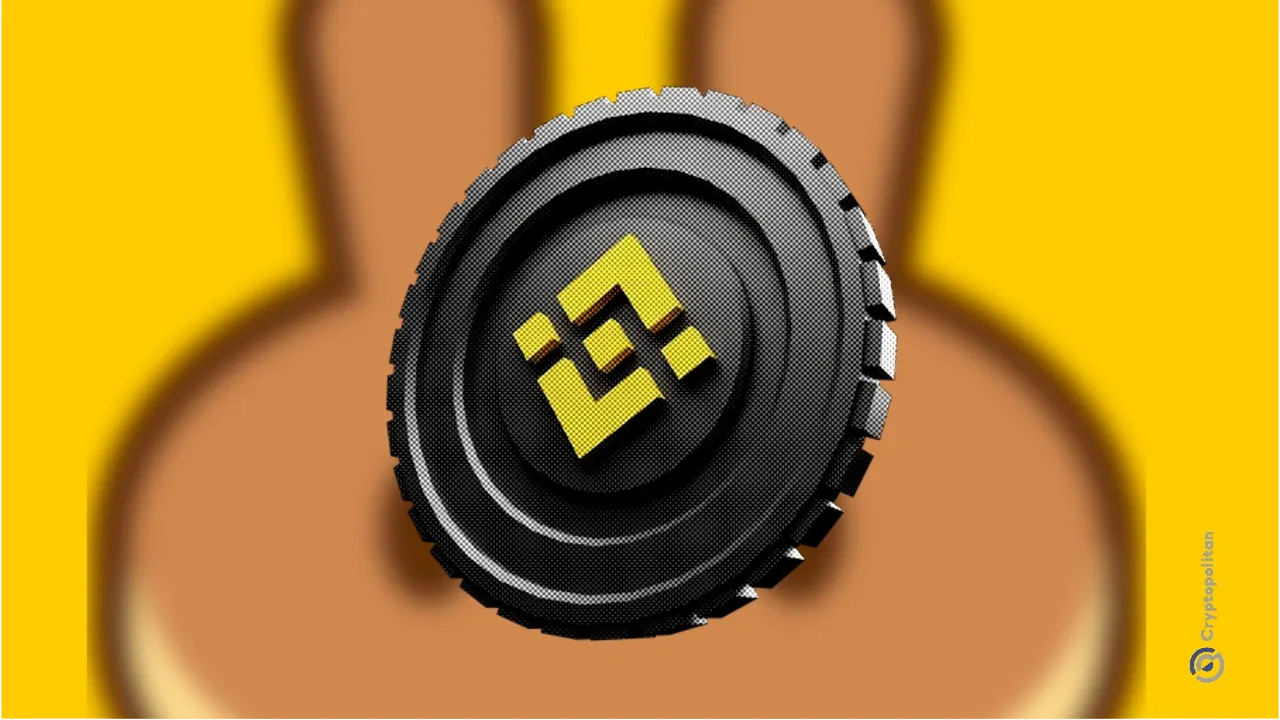
Background
BNB Chain has seen a 400% increase in gas fees, collecting nearly $15 million in transaction fees over the past week, more than double Ethereum’s total. This surge is driven by heightened memecoin speculation, leading to network congestion and prompting BNB Chain to implement an optimization favoring time-sensitive transactions.
Key Points
BNB Chain gas fees surged by 400%, surpassing Ethereum’s $7 million but trailing Solana’s $29 million.
New optimization prioritizes memecoin transactions, allowing validators to gather more bids and improve block-building performance during peak activity.
BSC’s fees increased by 114% in a week, while other major blockchains, including Ethereum and Solana, saw negative growth.
The hype around memecoins inspired by Binance founder CZ’s dog Broccoli has driven increased activity on the network and boosted PancakeSwap’s trading volumes.
- The fee surge coincides with Binance's recent 60-day legal battle pause with the SEC, possibly acting as a catalyst for renewed activity.
Key Takeaway
BNB Chain’s latest upgrade reflects the growing dominance of memecoin trading on its network, driving fees and congestion to historic levels. The move to prioritize these transactions underscores the increasing influence of speculative assets in shaping blockchain infrastructure.
Argentina’s President Javier Milei Faces Impeachment Risk Over $107M Libra Rug Pull

Background
Argentine President Javier Milei is facing impeachment calls after endorsing the Solana-based Libra (LIBRA) token, which collapsed in what analysts describe as an insider scam. The token briefly peaked at a $4.56 billion market cap before plummeting over 94% within 11 hours, leaving investors with heavy losses.
Key Points
Milei promoted Libra (LIBRA) on X (formerly Twitter), sharing its website and contract address before deleting the post.
The token surged to a $4.56 billion market cap on Feb. 14, then crashed to $257 million shortly after its trading debut.
Argentina’s fintech chamber acknowledged the case as a possible rug pull, prompting opposition lawmaker Leandro Santoro to call for Milei’s impeachment.
- Milei later denied any direct involvement, stating he was unaware of the project’s details and had “no connection whatsoever” with its launch.
Key Takeaway
Milei’s promotion of the now-collapsed Libra token has triggered a major political controversy, with impeachment discussions gaining traction. The incident raises concerns over government involvement in crypto endorsements and their impact on public trust.
Wrapped AVAX Sees Increased Accumulation Despite Price Drop
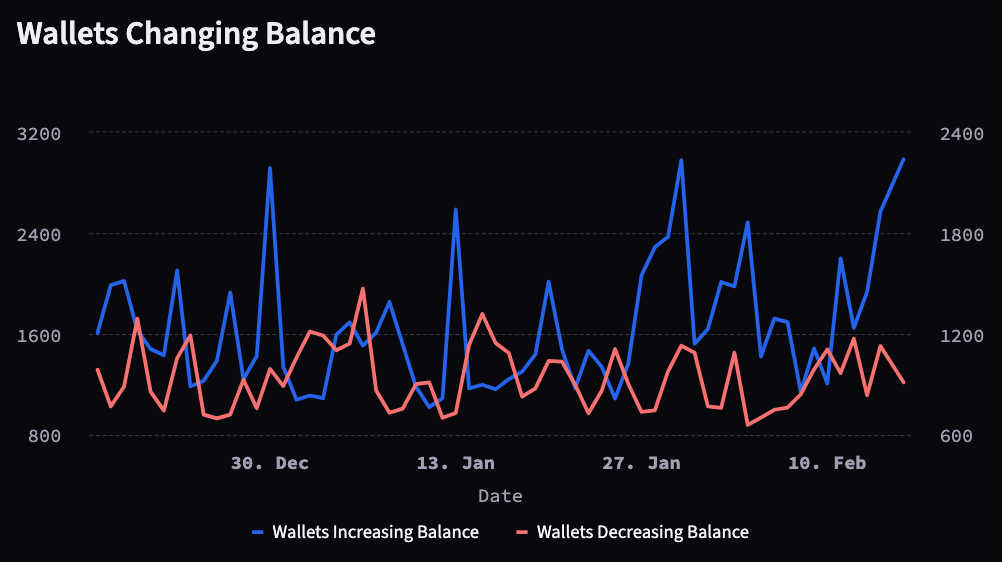
Background
Wrapped AVAX (WAVAX) has seen a surge in wallet accumulation, with nearly 4,000 wallets increasing their holdings, almost 1.8 times the recent average. This comes as WAVAX’s price dropped 4.5% in the past 24 hours, suggesting traders may be positioning for future activity despite market weakness.
Key Points
3,898 wallets added WAVAX holdings, up from the recent 1,600-wallet average, indicating increased confidence.
The accumulation follows AVAX’s addition as a cashback option for Binance’s Bybit Card, expanding its utility.
Avalanche’s DeFi ecosystem, including Aave and Lido, has seen a decline in total value locked, but trading volumes continue to grow.
- The Avalanche9000 upgrade and BlackRock’s tokenized fund integration have contributed to the ecosystem’s expansion.
Key Takeaway
Despite a 4.5% price drop, WAVAX accumulation is on the rise, hinting at traders’ long-term confidence in the Avalanche ecosystem and its DeFi growth potential.
CluCoin Founder Sentenced to 27 Months for Gambling Away Investor Funds

Background
Austin Michael Taylor, also known as DPN3, has been sentenced to 27 months in prison after pleading guilty to wire fraud for misusing $1.14 million in investor funds. Taylor, who launched CluCoin and Goobers NFTs, confessed in 2023 that he had lost all the money gambling online.
Key Points
Taylor raised funds through CluCoin’s ICO in 2021, using his large social media following to attract investors.
He later shifted focus to NFTs and Web3 projects, including Goobers NFTs, Gridlock (a play-to-earn game), and the Xenia metaverse.
In early 2023, he admitted to investors that he had lost all their funds gambling on Stake.
The FBI alerted fraud victims via NFT, launching an investigation that led to Taylor’s conviction.
- CluCoin once peaked at $17 million market cap, but now sits at just $54,133.
Key Takeaway
Taylor’s sentencing highlights the risks of unchecked influencer-driven crypto projects, where fund mismanagement and personal addictions can lead to devastating losses for investors.
$TRUMP Token Surges 35% to $24 Amid Political Memecoin Hype
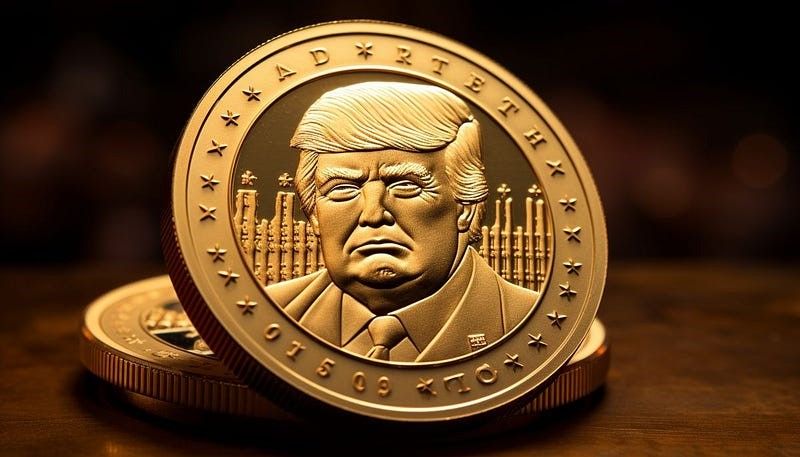
Background
Memecoins have become a major sector in the cryptocurrency market, now making up one-third of investor interest with a total market capitalization of $120 billion. Among them, the $TRUMP token has gained traction, reflecting political sentiment and trading momentum.
Key Points
$TRUMP token surged 35%, reaching $24, driven by political developments and investor speculation.
The memecoin sector has grown significantly, now valued at $120 billion, showing its dominance in the crypto space.
Investors can open large $TRUMP positions with minimal price impact, indicating strong liquidity and active trading.
- The token’s performance is closely tied to Donald Trump’s political actions and campaign influence.
Key Takeaway
The $TRUMP token’s rise highlights the growing financial influence of political memecoins, as traders capitalize on sentiment-driven volatility in the expanding $120 billion memecoin market.
KAITO Token Trades at $1.5B to $1.7B FDV in Pre-Market, YAPs Valued Up to $454 at TGE
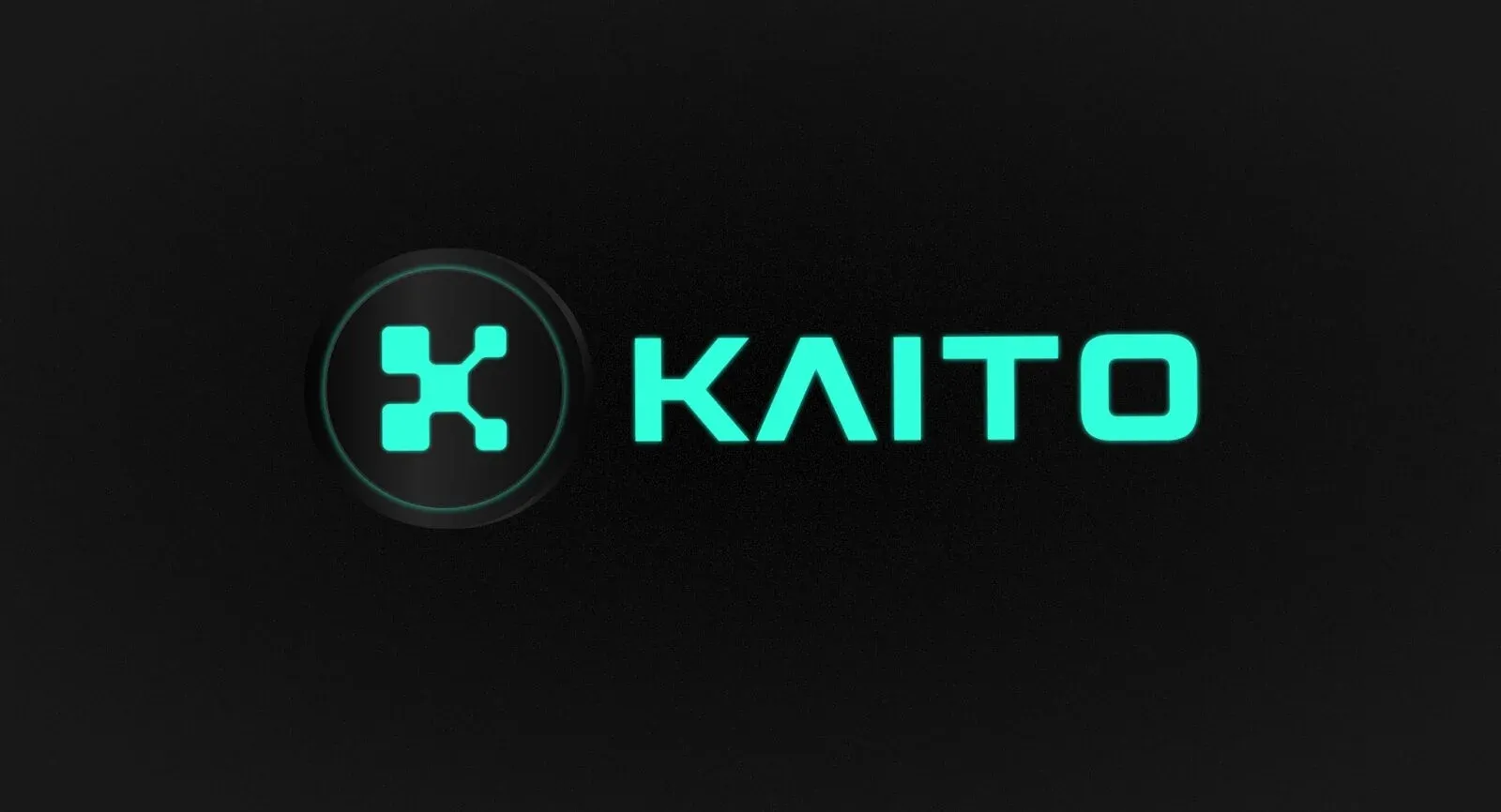
Background
The cryptocurrency token $KAITO is currently trading in the pre-market at a fully diluted valuation (FDV) of $1.5 billion to $1.7 billion, with trading volumes between $70,000 and $150,000. The token price is reported at $1.70 per token.
Key Points
$KAITO’s pre-market FDV ranges from $1.5B to $1.7B, with active trading volume.
YAPs, Kaito’s reward points, are valued between $50 and $454, depending on the source.
The Kaito Yapper program allows users to earn YAPs by engaging with crypto-related content on Twitter.
YAPs can be used for weekly voting and sold, with additional protocols set to reward Kaito users.
- Platforms like Azuki's Anime and Story’s IP have started distributing YAPs at the Token Generation Event (TGE).
Key Takeaway
$KAITO’s strong pre-market valuation and YAP integration highlight its growing role in crypto engagement incentives, with high expectations surrounding its token launch and ecosystem expansion.
Wallet Enables Zero-Fee USDT Deposits, Withdrawal Fees Remain Unchanged
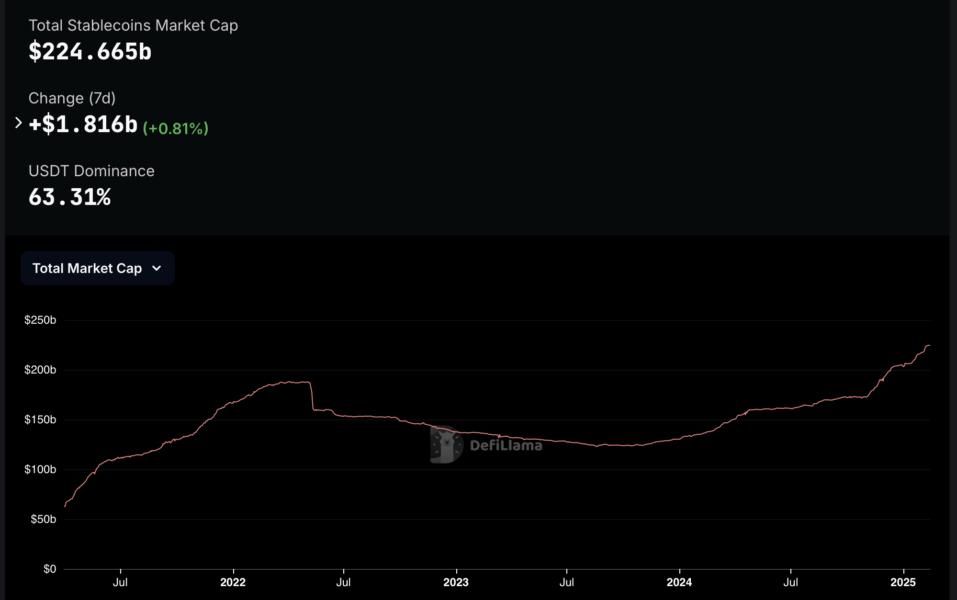
Background
Wallet, a custodial app integrated with Telegram, has announced zero-fee USDT deposits for eligible users in over 60 countries. While this move may improve liquidity and adoption, withdrawal fees remain unchanged, with 3.5 USDT on Tron and 1 USDT on TON.
Key Points
USDT deposits are now free for eligible Wallet users globally.
Withdrawal fees remain the same: 3.5 USDT on Tron and 1 USDT on TON.
USDT dominates 63.3% of the stablecoin market, but its share has been declining in 2025 as USDC supply grows.
Wallet is working toward MiCA compliance and aims to be fully compliant by the end of 2025.
- Stablecoin adoption is rising, with the Trump administration prioritizing stablecoin regulation in the U.S.
Key Takeaway
Wallet’s zero-fee USDT deposits could drive higher stablecoin usage, but unchanged withdrawal fees suggest a strategic balance between adoption and revenue generation.
Jupiter to Buy Back Over $100M in JUP Annually, Boosting Token Demand
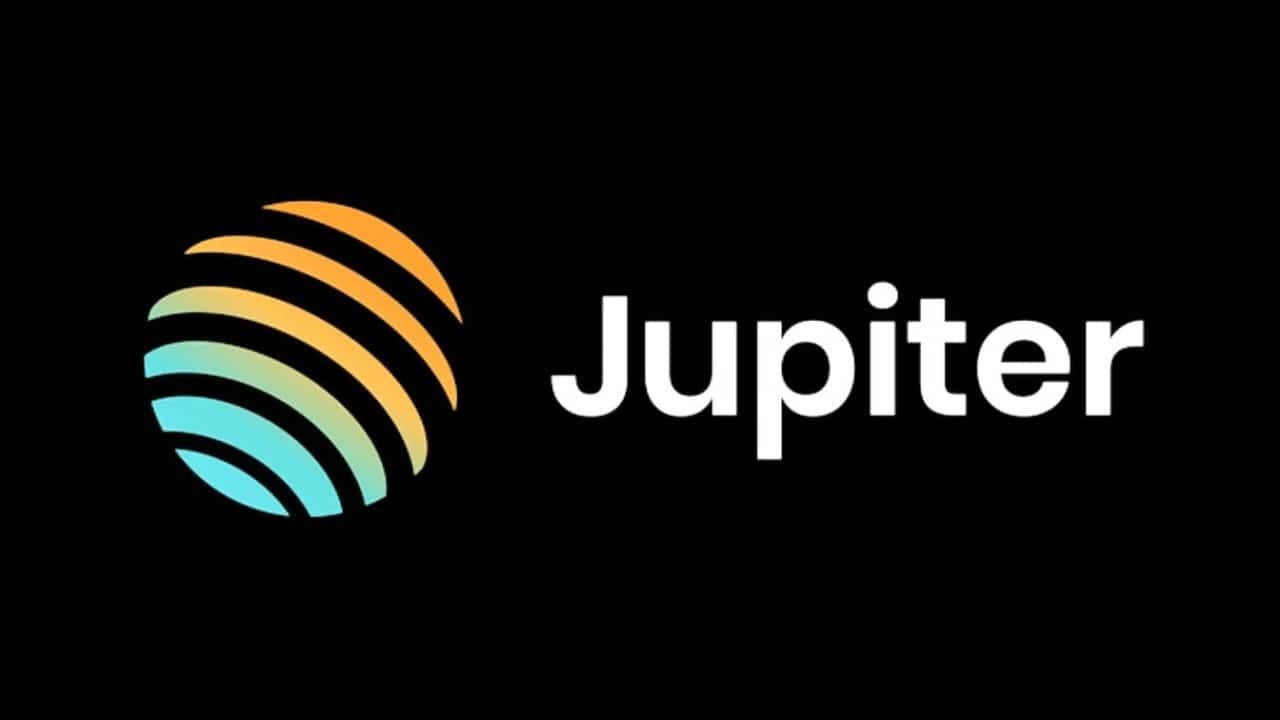
Background
Solana-based Jupiter Exchange, the most popular DEX aggregator by trading volume, has announced plans to buy back over $100 million worth of its JUP token annually. Starting Feb. 17, 50% of protocol revenue will be allocated to buybacks, with purchased tokens locked for three years.
Key Points
Jupiter will use 50% of protocol fees for JUP buybacks, reinforcing long-term demand.
Jupiter currently processes around $3.2 billion in daily volume, benefiting from Solana’s rising memecoin activity.
The DEX aggregator has earned roughly $6 million in fees since its inception.
Buybacks are part of a broader DeFi trend, with projects like Aave, Ethena, and Ether.fi implementing similar value-accrual mechanisms.
- Solana’s DeFi growth has propelled Jupiter’s dominance, surpassing Ethereum-based aggregators in trading volume.
Key Takeaway
Jupiter’s $100M+ annual buyback program strengthens JUP’s long-term demand, aligning with a growing DeFi movement toward revenue-sharing and value retention for tokenholders.
Sniper Nets $10 Million Amid ‘Broccoli’ Memecoin Frenzy Triggered by CZ’s Dog Reveal

Background
A memecoin sniper reportedly earned over $10 million by leveraging a smart contract to buy up large portions of new “Broccoli”-themed tokens on the Four.Meme platform, as interest soared following Binance Founder CZ revealing details about his dog, Broccoli.
Key Points
Automated Sniping Strategy: The sniper’s smart contract immediately purchased 50% of each newly launched Broccoli token in the same block they were created.
Rapid Buy-Sell Execution: The system bought at low prices and sold these tokens soon after, capturing over $10 million in profit during the meme-driven price surge.
Massive Token Launch: Platforms like Pump.fun and Four.Meme saw hundreds of Broccoli-themed coins appearing, reflecting the community’s frenzied speculation around CZ’s post.
- Controversy Over CZ’s Role: Critics claim that CZ’s promotion of the meme driven by his dog’s name “revitalized BSC” in a way some perceive as selfish. CZ responded, acknowledging he wanted to boost BNB Chain’s activity but didn’t want to create a meme coin himself.
Key Takeaway
The $10 million windfall for a single sniper highlights both the explosive volatility of memecoins and the importance of rapid-trade automation. While it underscores the opportunistic nature of meme-driven tokens, it also raises questions about influencer impact on market speculation and community-driven token launches.
Coinbase Partners With Aston Martin F1 Team in USDC-Paid Sponsorship Deal
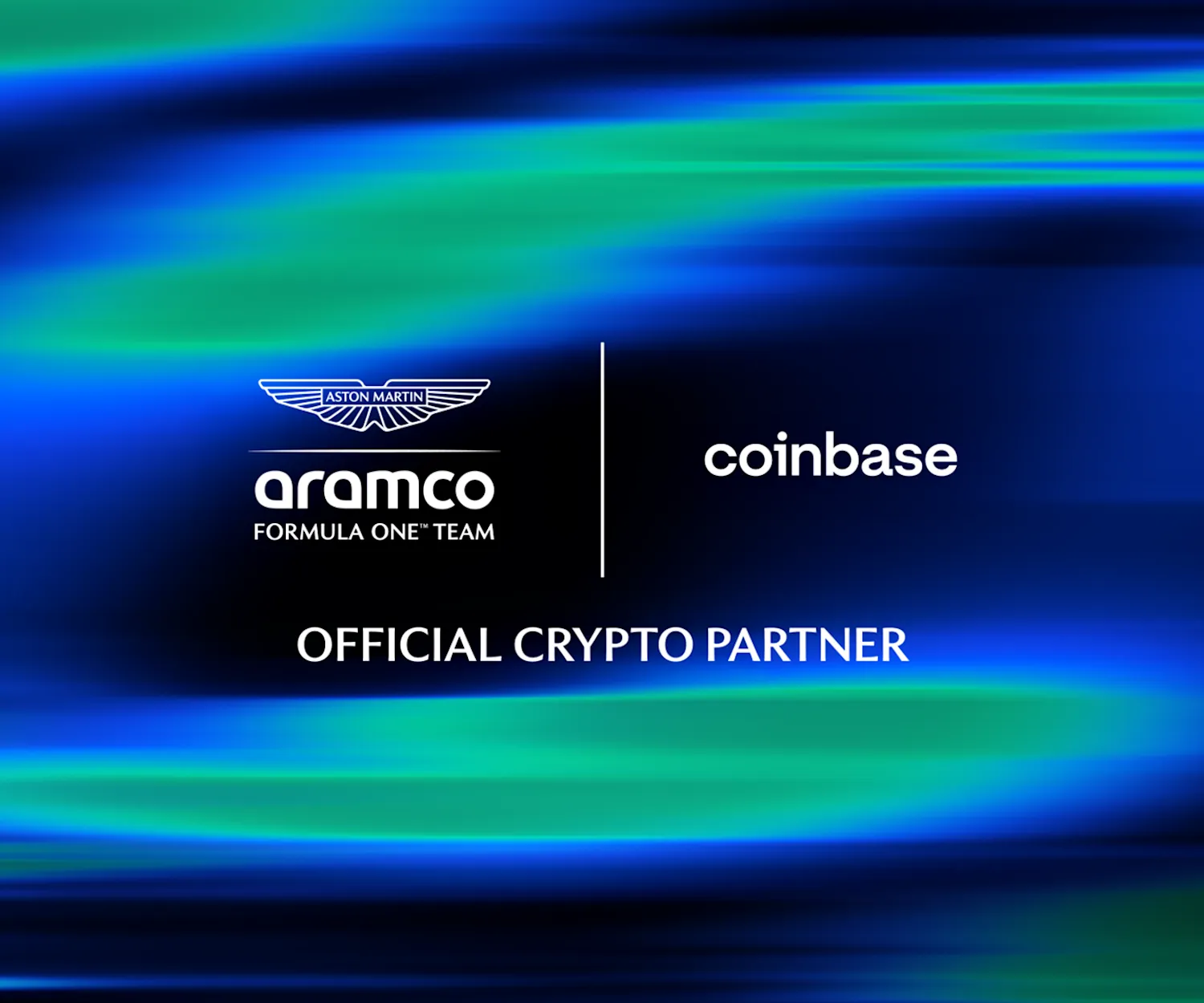
Background
Coinbase has secured a sponsorship deal with Aston Martin’s Formula One team, making it an official partner for the 2025 F1 season. The entire deal is uniquely paid in USDC, highlighting the growing adoption of stablecoins for major corporate transactions.
Key Points
Coinbase branding will appear on Aston Martin’s AMR25 car and the racing suits of Fernando Alonso and Lance Stroll.
The deal is fully paid in USDC, as Aston Martin opted for stablecoin payments due to faster cross-border transactions and lower fees.
Aston Martin is also onboarding as a prime institutional customer of Coinbase, expanding their partnership beyond marketing.
- The crypto industry’s presence in F1 is growing, with previous sponsorships from Crypto.com and Stake securing high-profile branding deals.
Key Takeaway
Coinbase’s USDC-based sponsorship of Aston Martin signals a major step toward stablecoin adoption in mainstream industries, reinforcing crypto’s expanding influence in global sports partnerships.
BNB Chain Overtakes Solana in Daily Fees, Leading All Blockchains
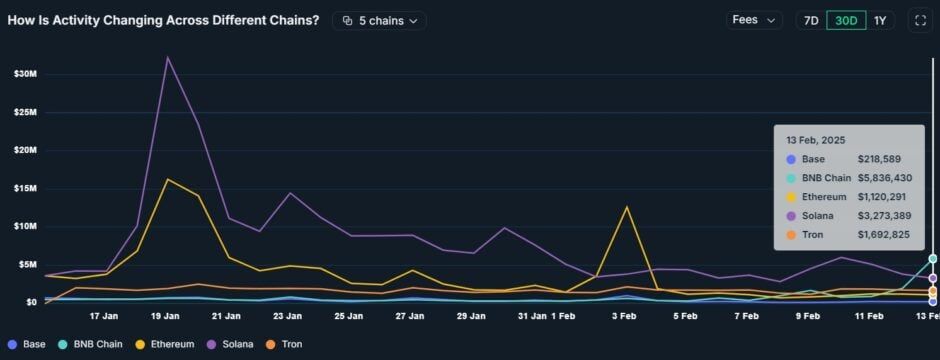
Background
BNB Chain has surpassed Solana in daily fees for the first time since October 2024, generating $5.8 million on February 13. This marks the first time since Bitcoin’s October surge that a blockchain other than Ethereum or Solana has led in daily fee revenue.
Key Points
BNB Chain generated $5.8 million in daily fees, surpassing Solana’s $3.3 million and exceeding Ethereum’s total fivefold.
PancakeSwap led all decentralized exchanges in trading volume, further boosting BNB Chain’s fee revenue.
BNB Chain also surpassed Tron and Ethereum in daily active addresses, ranking second behind Solana’s 35.8 million active users over the past seven days.
A major driver of BNB Chain’s activity has been the rise of memecoins, including the speculative trading frenzy around the TST token, which briefly reached a $500 million market cap.
- BNB token (BNB) surged 15% this week, overtaking Solana’s SOL to become the fifth-largest cryptocurrency by market capitalization.
Key Takeaway
BNB Chain’s dominance in daily fees and active users signals its growing role in the crypto ecosystem, fueled by DEX activity and memecoin speculation, positioning it as a serious competitor to Solana and Ethereum.
GameStop Surges 18% After-Hours on Bitcoin Investment Speculation
Background
GameStop’s stock price jumped 18% in after-hours trading following reports that the company is considering investing in Bitcoin and other alternative assets. While no official confirmation has been made, speculation has been fueled by CEO Ryan Cohen’s recent meeting with MicroStrategy’s Michael Saylor.
Key Points
GameStop shares surged to $31.30 in after-hours trading before cooling to $28.36, still up 7%.
A Solana-based GameStop (GME) memecoin, unrelated to the company, rose 45% before retreating.
Sources claim GameStop is still evaluating crypto investments, and Saylor is reportedly not involved in any decision-making.
Other firms, like Gumi and Metaplanet, have recently added Bitcoin to their balance sheets, signaling a growing corporate trend.
- GameStop previously launched and later shut down its NFT marketplace and crypto wallet, citing regulatory concerns.
Key Takeaway
GameStop’s potential Bitcoin investment has sparked renewed meme stock hype, though regulatory concerns and past crypto setbacks may impact its final decision.
Ethereum Foundation Deposits Over $100M in ETH into DeFi Lending Protocols
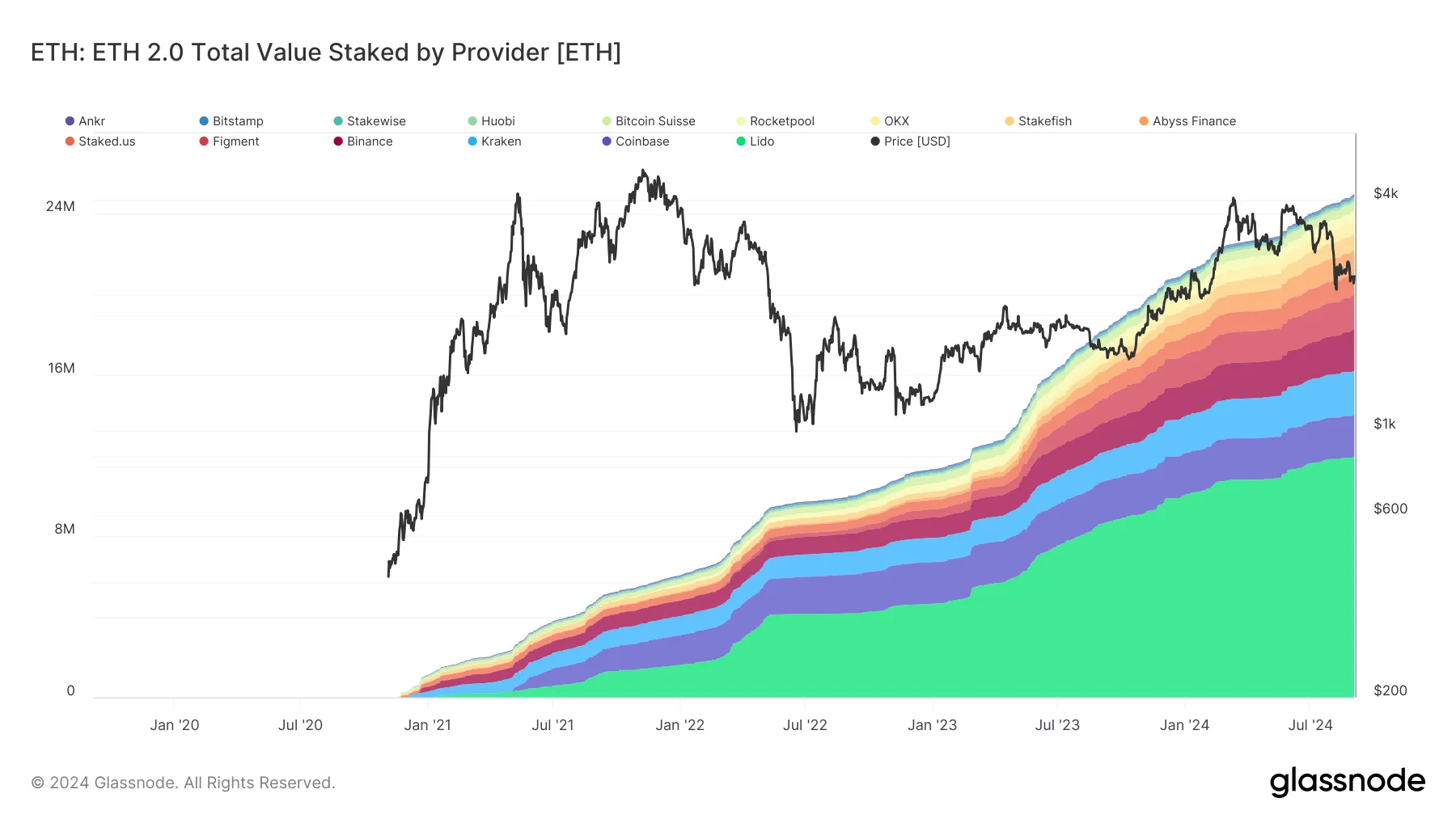
Background
The Ethereum Foundation (EF) has allocated nearly 45,000 ETH (approximately $118 million) to DeFi lending protocols, including Aave, Spark, and Compound. The move follows community pressure for the EF to demonstrate greater support for Ethereum-based dApps.
Key Points
30,800 ETH (~$81.6M) was deposited into Aave, with 20,800 ETH in Aave’s core market and 10,000 ETH in Aave Prime.
10,000 ETH was transferred to Spark, a lending protocol operated by Sky (formerly MakerDAO).
4,200 ETH was allocated to Compound, marking further EF involvement in DeFi liquidity.
The EF anticipates earning ~$1.5M in annualized yield at a 1.5% supply rate from these deposits.
- The move comes after community backlash over the EF’s ETH sales, with recent transactions prompting concerns about its commitment to the ecosystem.
Key Takeaway
The Ethereum Foundation’s large-scale DeFi deposits signal renewed support for Ethereum’s lending protocols, potentially strengthening the ecosystem while also generating passive yield for the foundation.
OpenSea Goes Multichain After 98% Volume Collapse, Plans SEA Token Airdrop

Background
Once the dominant NFT marketplace, OpenSea has seen a 98% decline in trading volume since its 2022 peak. In response, the platform is expanding to multiple blockchains, launching a SEA token airdrop, and revamping its website in an effort to regain market share.
Key Points
OpenSea is adding support for over a dozen blockchains, allowing users to purchase NFTs across chains, such as buying Solana NFTs with non-Solana assets.
Marketplace fees are being cut to 0.5%, and swap fees are reduced to $0 in the new OS2 Open Beta.
Trading volumes have collapsed from $476M in May 2022 to single-digit millions today, with NFT sales down 80% since 2022.
OpenSea’s royalty fees plummeted from $268M in January 2022 to under $4M last month.
- Fierce competition from Blur and Magic Eden has forced OpenSea to adopt a multichain approach, mirroring strategies that helped Magic Eden grow.
Key Takeaway
OpenSea’s multichain expansion and SEA token launch aim to revive the struggling NFT marketplace, but with NFT demand declining in favor of memecoins, it remains unclear whether these changes can reverse its downward trend.
OpenAI CEO Sam Altman Confirms GPT-5 Launch in the Coming Months
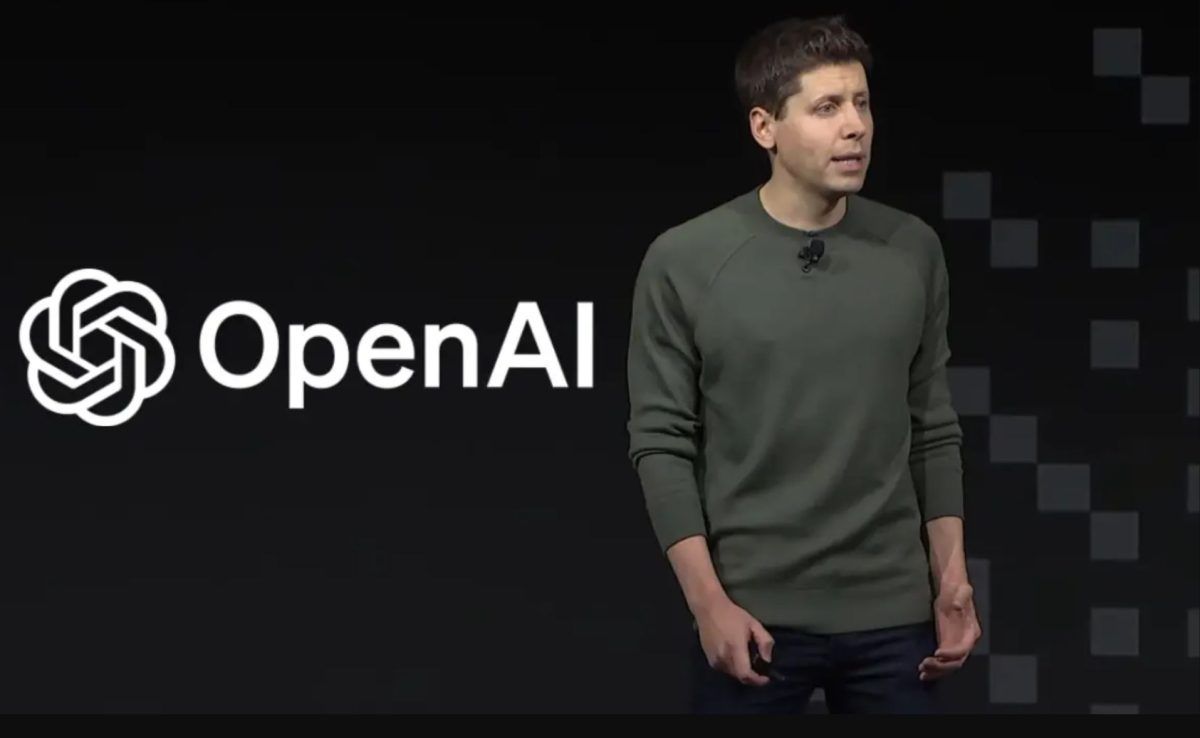
Background
OpenAI CEO Sam Altman has announced that GPT-5 will be released within the next few months, following the launch of GPT-4.5 (Orion). The new model will unify OpenAI’s o-series and GPT-series, integrating advanced reasoning capabilities into a single system.
Key Points
GPT-4.5 (Orion) will launch first, serving as OpenAI’s last non-chain-of-thought model before GPT-5.
GPT-5 will integrate multiple technologies, including OpenAI’s o3 reasoning model, which improves fact-checking and minimizes misinformation.
Free users will have limited access to GPT-5, while premium and pro users will experience higher-level intelligence capabilities.
The AI race is intensifying, with competitors like DeepSeek and Google’s Gemini 2.0 pushing advancements in AI-powered autonomous agents.
- Microsoft and OpenAI are investigating potential data leaks linked to DeepSeek’s development, further escalating industry competition.
Key Takeaway
The imminent launch of GPT-5 signals a major step forward for AI, integrating enhanced reasoning and efficiency, while competition from DeepSeek and Google fuels the rapid evolution of AI technology.